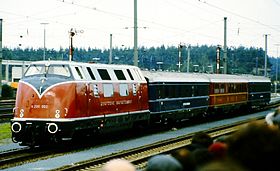DB Class V 200
| DB Class V200 DB Class 220 SBB Am 4/4 |
|
|---|---|

Prototype museum engine V 200 002
|
|
| Number(s) | V200 001-086, from 1968 220 001-086 |
| Quantity | 86 |
| Manufacturer | Krauss-Maffei, MaK |
| Year(s) of manufacture | 1953; 1956–1958 |
| Retired | 1984 |
| Axle arrangement | B'B' |
| Track gauge |
1,435 mm (4 ft 8 1⁄2 in) standard gauge 1,668 mm (5 ft 5 21⁄32 in), Spain |
| Length over buffers | 18.47 m (60 ft 7 1⁄8 in) (prototype), 18.53 m (60 ft 9 1⁄2 in) (production) |
| Service weight | ca 80.0 t (78.7 long tons; 88.2 short tons) |
| Axle load | ca 20.0 t (19.7 long tons; 22.0 short tons) |
| Top speed | 140 km/h (87 mph) |
| Power output (continuous) | 1,618 kW (2,170 hp) |
| Motor make/model | Maybach or Mercedes |
| Motor type | 2 x V12 diesel |
| Transmission | Hydraulic |
| Locomotive brakes | direct-release, compressed air brake + aux. brake, K-GPR mZ; later: graduated, compressed air brake + aux. brake, WS-GPP2R mZ |
DB Class V 200.0 (from 1968: Class 220) was the first series production diesel-hydraulic express locomotive of the German Deutsche Bundesbahn and - as Am 4/4 - of the SBB-CFF-FFS in Switzerland.
Five prototypes of the V 200 were built by Krauss-Maffei in 1953/1954. Full production began in 1956, with 61 engines being built by Krauss-Maffei and 20 by MaK.
The five V 200.0 prototypes were put through extensive testing, the aim being to ensure the production locomotives would be as reliable as the technology and maintenance standards of the 1950s allowed. In 1955 one locomotive travelled under its own power through Yugoslavia, Greece and Turkey partly as a test and partly to demonstrate the locomotive's capability to potential customers in those countries.
Initially the V 200 hauled express trains on all main lines, replacing the DRG Class 05, DRG Class 03 and DRG Class 01. Following the electrification of many main lines the V 200 was used increasingly for commuter trains and freight trains, but the Hamburg-Westerland, Hamburg-Lübeck-Copenhagen and Munich-Lindau lines still saw the V 200 hauling express trains.
From 1962, the V 200.0 was followed by the more powerful DB Class V 200.1, later Class 221.
From 1977, the V 200.0s were concentrated in northern German engine sheds (Bahnbetriebswerke). These two-engine locomotives were more expensive to operate than single-engine locomotives like DB Class V 160. A further disadvantage was its steam heating system for carriages, since replaced by electric train heating. The last V 200 went out of service with the DB in 1984.
...
Wikipedia
